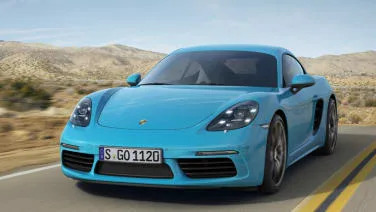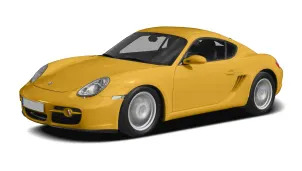2008 Porsche Cayman
2008 Porsche Cayman S – Click above for high-res image gallery To many, the Porsche Cayman is just a look-alike twin to the drop-top Porsche Boxster. While it shares a platform, underpinnings, and even engine choices with its two-seat sibling, the Cayman performs a decidedly different role and delivers even more gratifying performance. Porsche dropped off a top-of-the-line Cayman S in the Autoblog Garage. It offers a more powerful engine and larger brakes over the standard Cayman model. Follow the jump to read our impressions on the Porsche Cayman S after we held the keys in our hands for a week. %Gallery-26436% All photos copyright Michael Harley / Weblogs Inc. To understand the Cayman, you have to know a bit about the Porsche Boxster and the 911, as the relationship between the three is much deeper than the badge. In the early 1990s, Porsche penned a modern-day reincarnation of its first production car, the 356. Engineered from the ground-up to be a convertible, this all-new roadster (type "986") would offer a mid-engine design and seating for just two. Most importantly, much of the engineering work would pave the way for the first water-cooled mainstream 911 (type "996"). With the new Boxster and 996 sharing mechanicals, Porsche would save tens of millions in design, tooling, and manufacturing. The first Boxster models arrived in 1996. With a 2.5-liter flat-six mounted seemingly inaccessible in the middle of the car, they were underpowered but offered world-class handling (in fact, with the prices of these early models falling, a new class of "Spec Boxster racing" has emerged). To the angst of many Porschephiles, from the A-pillar forward the early Boxster was indistinguishable from the new 911. That changed in 2005 when the Boxster was significantly updated inside and out (enough changes to justify a new type number, the "987"). It was that revised vehicle that formed the platform for the soon-to-arrive Cayman. Arriving in 2006, the closed-roof Porsche Cayman (type "987c") offered a more powerful engine, and a chassis that was 100 percent more rigid than the Boxster. This stiff platform allowed Porsche engineers the freedom to recalibrate the suspension for a sportier ride and even higher performance. The placement of the all-aluminum engine not only differentiates the Cayman from the venerable Porsche 911, but it defines the vehicle's handling traits. Many will argue mid-engine placement is paramount for optimal handling, braking, and acceleration (witness the McLaren F1, Ferrari Enzo, and more recent Audi R8). With both passengers and the engine situated between the axles, weight distribution on the Cayman S is split 45% front, 55% rear. The curb weight, even with a full complement of safety equipment and six airbags, is listed at just 2,976 pounds. The Cayman S in our garage was lightly equipped (for a Porsche) with a base price of $59,100. A few select packages (Preferred, Xenon, Sport Chrono, etc...) and custom silver seat belts pushed it to a semi-reasonable $65,780, depending on your perspective. Designed with a low center …
Full Review
2008 Porsche Cayman S – Click above for high-res image gallery To many, the Porsche Cayman is just a look-alike twin to the drop-top Porsche Boxster. While it shares a platform, underpinnings, and even engine choices with its two-seat sibling, the Cayman performs a decidedly different role and delivers even more gratifying performance. Porsche dropped off a top-of-the-line Cayman S in the Autoblog Garage. It offers a more powerful engine and larger brakes over the standard Cayman model. Follow the jump to read our impressions on the Porsche Cayman S after we held the keys in our hands for a week. %Gallery-26436% All photos copyright Michael Harley / Weblogs Inc. To understand the Cayman, you have to know a bit about the Porsche Boxster and the 911, as the relationship between the three is much deeper than the badge. In the early 1990s, Porsche penned a modern-day reincarnation of its first production car, the 356. Engineered from the ground-up to be a convertible, this all-new roadster (type "986") would offer a mid-engine design and seating for just two. Most importantly, much of the engineering work would pave the way for the first water-cooled mainstream 911 (type "996"). With the new Boxster and 996 sharing mechanicals, Porsche would save tens of millions in design, tooling, and manufacturing. The first Boxster models arrived in 1996. With a 2.5-liter flat-six mounted seemingly inaccessible in the middle of the car, they were underpowered but offered world-class handling (in fact, with the prices of these early models falling, a new class of "Spec Boxster racing" has emerged). To the angst of many Porschephiles, from the A-pillar forward the early Boxster was indistinguishable from the new 911. That changed in 2005 when the Boxster was significantly updated inside and out (enough changes to justify a new type number, the "987"). It was that revised vehicle that formed the platform for the soon-to-arrive Cayman. Arriving in 2006, the closed-roof Porsche Cayman (type "987c") offered a more powerful engine, and a chassis that was 100 percent more rigid than the Boxster. This stiff platform allowed Porsche engineers the freedom to recalibrate the suspension for a sportier ride and even higher performance. The placement of the all-aluminum engine not only differentiates the Cayman from the venerable Porsche 911, but it defines the vehicle's handling traits. Many will argue mid-engine placement is paramount for optimal handling, braking, and acceleration (witness the McLaren F1, Ferrari Enzo, and more recent Audi R8). With both passengers and the engine situated between the axles, weight distribution on the Cayman S is split 45% front, 55% rear. The curb weight, even with a full complement of safety equipment and six airbags, is listed at just 2,976 pounds. The Cayman S in our garage was lightly equipped (for a Porsche) with a base price of $59,100. A few select packages (Preferred, Xenon, Sport Chrono, etc...) and custom silver seat belts pushed it to a semi-reasonable $65,780, depending on your perspective. Designed with a low center …
Hide Full Review
Hide Full Review
Retail Price
$49,400 - $49,400
MSRP / Window Sticker Price
| Engine | 2.7L H-6 |
| MPG | Up to 20 city / 29 highway |
| Seating | 2 Passengers |
| Transmission | 5-spd man w/OD |
| Power | 245 @ 6500 rpm |
| Drivetrain | rear-wheel |
| Curb Weight | 2,866 lbs |
Smart Buy Program is powered by 





